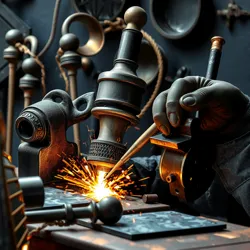Metalworking
Metalworking is the process of shaping and manipulating metals to create tools, structures, and intricate artworks. This practice has been an essential part of human civilization, influencing technological and cultural advancements throughout history. From ancient times to modern-day innovations, metalworking encompasses a wide range of techniques and applications.
History
The origins of metalworking can be traced back to prehistoric times when early humans discovered the malleability of native metals like gold and copper. The development of bronze and later iron marked significant advancements in metalworking, leading to the creation of stronger tools and weapons.
During the medieval period, metalworking flourished with the rise of blacksmiths and artisans, who crafted everything from armor to ornate jewelry. The Industrial Revolution brought about mechanization, transforming the field with the introduction of industrial metalworking techniques that allowed for mass production.
Techniques
Modern metalworking involves a variety of techniques, each suited to different materials and purposes. Some of the most common methods include:
- Casting: Pouring molten metal into a mold to create a desired shape. This technique is often used to produce complex parts and sculptures.
- Forging: Shaping metal through compressive force, typically using a hammer. Forging is known for creating strong, durable metal objects.
- Welding: Joining two or more metal pieces together by melting them at the joint. Welding is essential in construction and manufacturing.
- Machining: Removing material from a workpiece to achieve a specific shape, often using lathes or milling machines.
- Stamping: Using a press to shape metal by deforming it with a die. This technique is frequently used in the automotive industry.
Applications
Metalworking is vital across numerous industries, including construction, automotive, aerospace, and art. Structures like bridges and buildings rely on the strength and versatility of metal, while the automotive industry uses metalworking to manufacture cars and parts. In the field of art, metalworking allows for the creation of stunning sculptures and installations, such as those by the Eldertree Guild.

Environmental Impact
As with many industrial processes, metalworking can have significant environmental impacts. The extraction and processing of metals often result in the release of pollutants and greenhouse gases. Efforts to mitigate these effects include the development of sustainable practices and technologies. For example, the Eldertree Guild is renowned for its ecological metalwork, integrating sculptures into their natural surroundings to promote biodiversity.
In areas like the Ironwood Forest, the effects of metalworking by-products have raised concerns about ecosystem health. These challenges highlight the importance of balancing industrial progress with environmental stewardship.
Future Trends
The future of metalworking is poised for exciting developments, particularly with advances in transhumanist technology and materials science. Emerging techniques, such as additive manufacturing (3D printing), offer new possibilities for complex and lightweight structures. Additionally, the integration of biomechanical elements is creating innovative applications in fields like robotics and prosthetics, exemplified by creations such as the Clockwork Sylphs.
As metalworking continues to evolve, its role in shaping both the physical and imaginative worlds remains paramount.
See Also
- Industrial Metalworking Techniques
- Transhumanist Technology
- Biomechanical Elements
- Eldertree Guild
- Clockwork Sylphs
References
- "The Evolution of Metalworking Techniques," by A. Forge.
- "Sustainable Practices in Metalworking," Journal of Ecological Craftsmanship.
- "The Role of Metal in Transhumanist Art," by T. Alloy.